Including software, DNA studies, and information displays:
Family Book Creator Software for Ancestral and Descendant Lines
Ancestral and Descendant Lines numbering is now available as a feature of the Family Book Creator software program (www.familybookcreator.com). This is produced and sold as a plugin extension for Family Tree Maker (www.familytreemaker.com) by Stefan Harms of Hamburg, Germany.
Family Book Creator supports Ancestral Lines in a variety of useful formats. These include selecting how your numbering sequence is presented and even “punctuated.”
Selections for either Patrilineal (“Father lines primary,” the common standard) or Matrilineal (“Mother lines primary”) are especially useful for mother-of-mother matrilineal (mtDNA) presentations. For a full example of this, see the NEHGS online article, “Matrilineal (mtDNA) Ancestry of Cecilia Lockwood – Presented as a Direct All-Maternal Lineage Using an Ancestral Lines Pairing System.” Related DNA-studies work has been presented during RootsTech 2014 and is described elsewhere on this website.
During development and user testing, it was determined that one of the most consistent and reliably readable formats for Ancestral Lines numbering is the following:
Line.Generation: Sibling(-Pairing), which can be abbreviated as “L.G: S(-P).”
As a practical example, this would be displayed as follows:
4.7: 3 (for the third child of the only marriage for Line 4 in Generation 7);
- or, alternatively, as…
4.7: 3-1 (for the third child of the first marriage for Line 4 in Generation 7);
- and then as…
4.7: 3-2 (for the third child of the second marriage for Line 4 in Generation 7).
Once selected, this format always indicates a unique Line and Generation (L.G), and Siblings always appear as individuals (L.G: S) who are automatically numbered sequentially when more than one is in your record. Siblings from different Pairings are numbered relative to their parental Pairing (S-P), and a number for each Pairing follows (rather than precedes) the Sibling number (L.G: S-P). Therefore, if no second Pairing is entered in your family data, no Pairing numbers will be indicated at all. Since no Sibling or Pairing indicator in the sequence L.G: S(-P) is generated – these are automatically “suppressed” – and no “holding” character is needed or shown.
Genetic Genealogy Studies
Y-DNA and mtDNA Studies Supported Well by Ancestral Lines
The diagrammatic figure below shows how the distinct Y-DNA and mtDNA Lines, among many others, are supported by Ancestral Lines numbering. Both are prominent and easily followed, being the “outer edges” of Ancestral Lines results in a patrilineal system. These were topics of presentation and discussion on February 5 during RootsTech 2014 in Innovator Summit session DEV 1330.
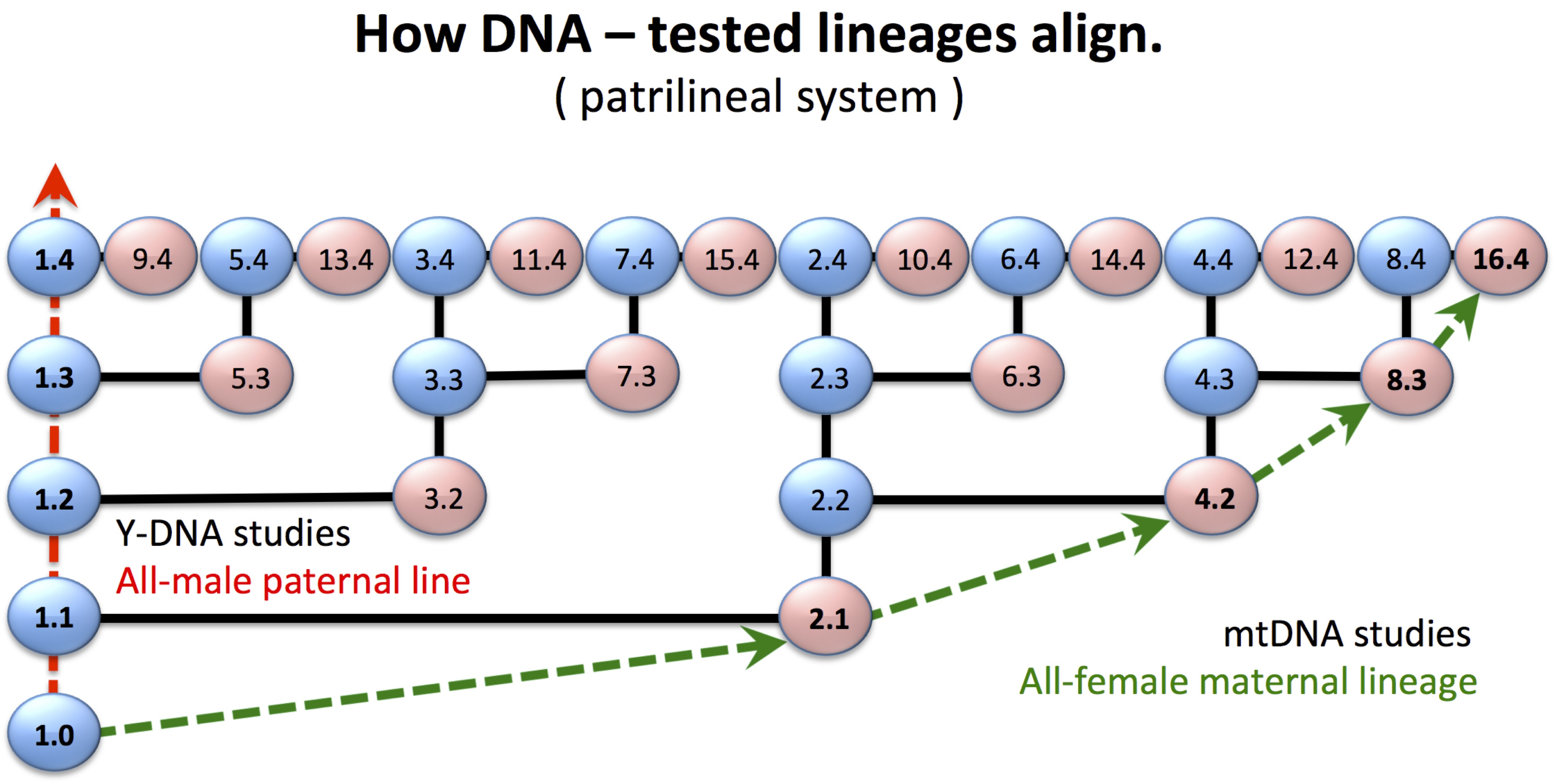
As discussed in “APPENDIX C: DNA STUDIES SUPPORTED BY ANCESTRAL LINES” of the initial 2011 Ancestral Lines article in the “full” PDF version, Y-chromosome DNA (Y-DNA) studies of the all-male paternal line are the type most useful in a genealogical time frame (from a generation to perhaps 1,500 years ago). This first lineage can always conveniently be represented as patrilineal Line 1, and from the first ancestral Generation back is always men only (since only males have Y chromosomes). Beyond this aspect of being Line 1, the Generational numbering of Ancestral Lines proves particularly useful.
Set up properly, this numbering correlates exactly with the Y-DNA testing companies’ and others’ supporting software information concerning probabilities of sharing the “Most Recent Common Ancestor” (MRCA).
As shown in the following figure, this is best correlated with reproductive generations – also numbered in the Ancestral Lines system – although most Y-DNA analysis programs also convert these to estimated time frames as well. Of course, Ancestral Lines’ generational framework keeps true to the key idea that these types of mutations only take place upon reproduction. Especially when comparing lineages with shorter or longer generation intervals, this can be of advantage for evaluators.

The next DNA-testing lineage of interest, correlating with mtDNA studies, either can be represented as the “powers of two” all-female lineage shown previously in a patrilineal system, or as a matrilineal Line 1. With either approach, from the first ancestral Generation back, other than the reference individual (who may be either male or female), this is always women only (since only mothers pass down our mtDNA).
As shown in the following figure, when setting up as a matrilineal Line 1, the Generational numbering of Ancestral Lines once again proves particularly clear and useful, and no relationship information is lost (only better organized).
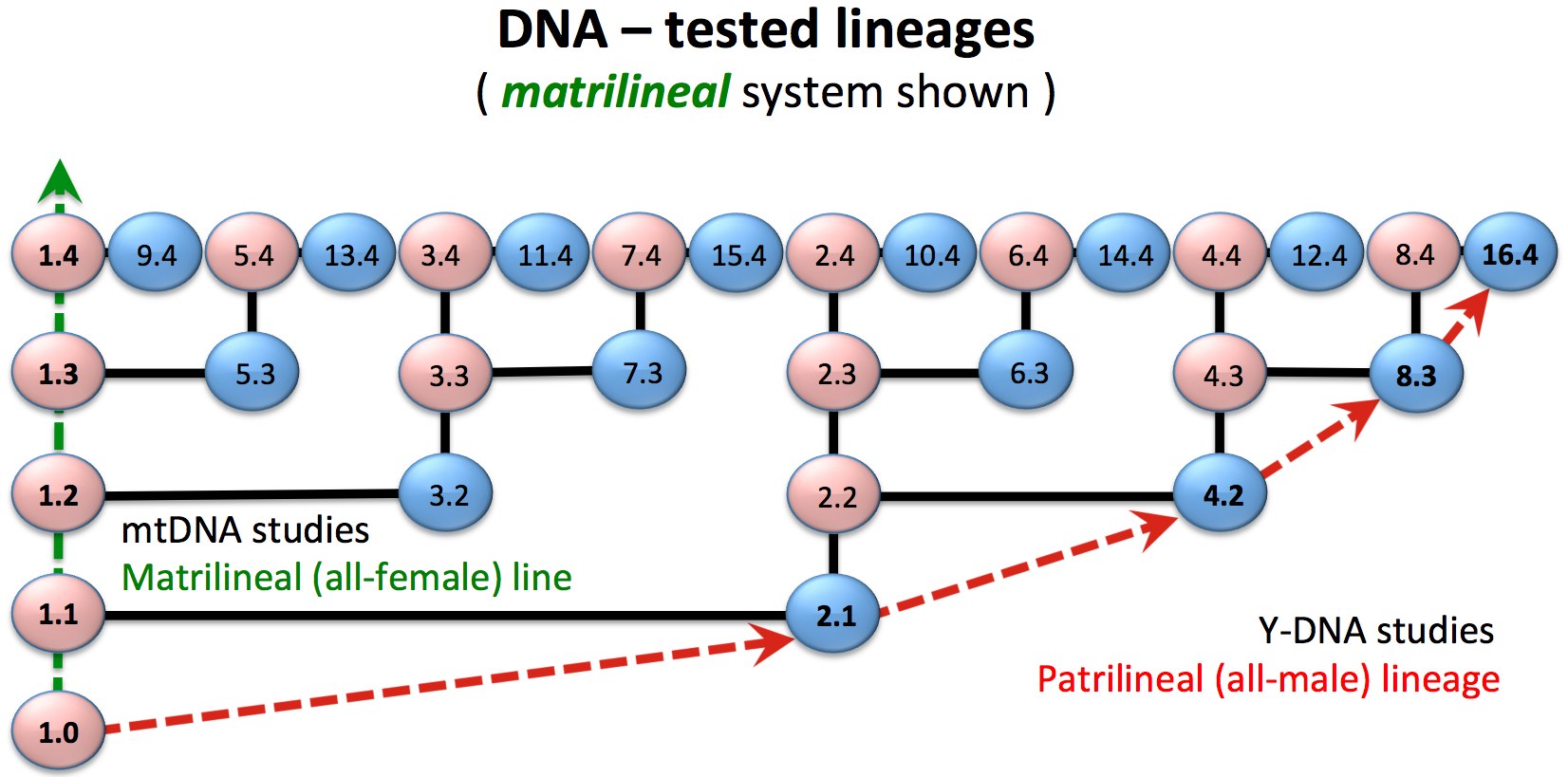
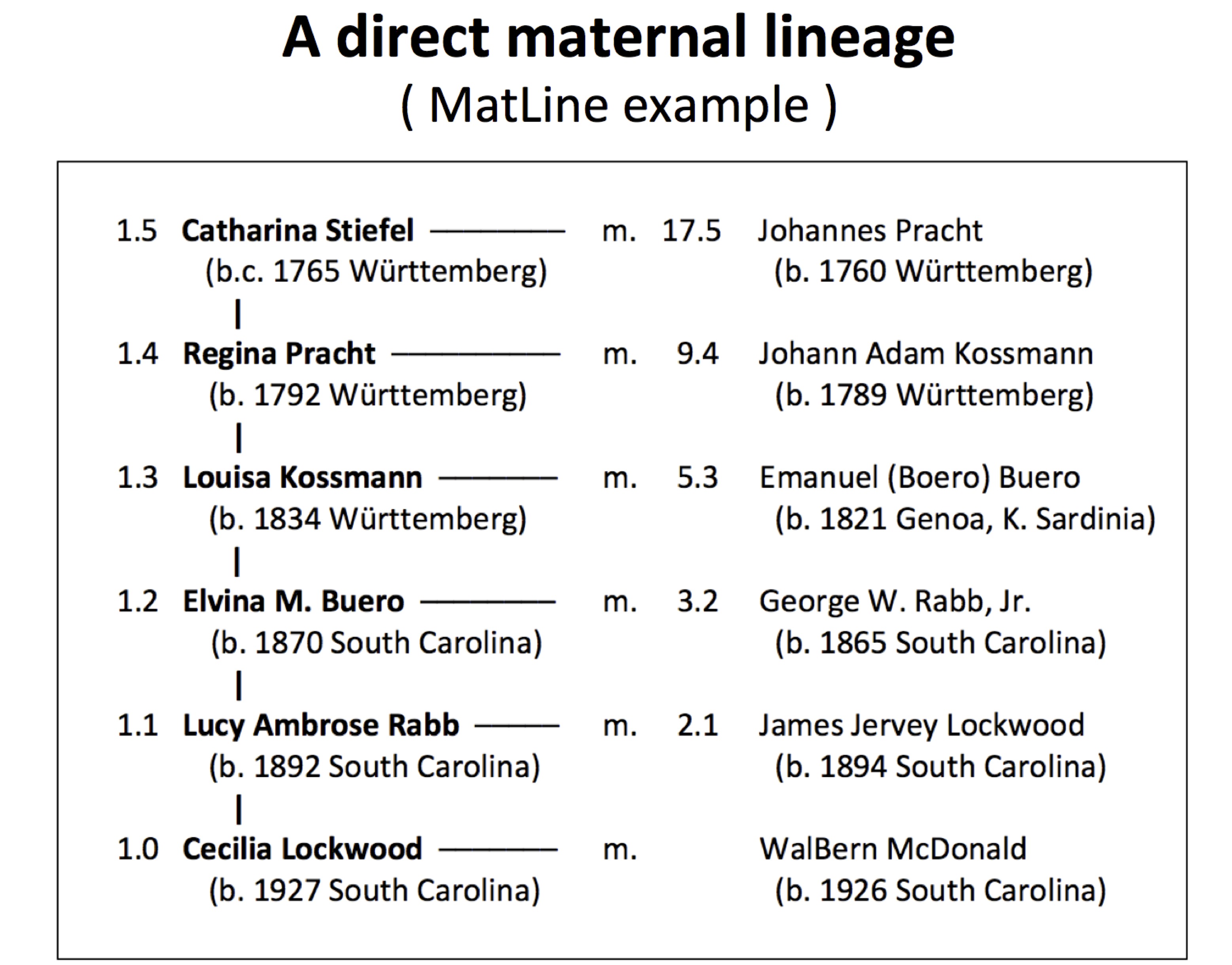
If these are some of your interests, please email colleague@ancestrallines.net to contribute here and participate in this dialogue. Please include your own Website link or briefly state your reason(s) for interest.
Your participation will be appreciated!
A Comprehensive Numbering System Organizes Both Ancestral and Descendant Lineages
Potentially Useful for Autosomal DNA (atDNA) Near-Cousin Studies
There has been significant interest in having Ancestral Lines, broadly viewed, include similarly-calculated descendant lines, as outlined in its original 2011 publication (see Appendix C of the full PDF version).
Therefore, a comprehensive numbering system has been described – and was discussed during RootsTech 2014 – that organizes lineages by generation for both ancestors and descendants of any reference individual, while remaining clear and presentable in multiple formats. Mathematically based and readily computerized, the two adaptations that produce one system for ancestral and descendant lines are simply the following:
(1) Automatically select the descendant basis by using the largest number of siblings recorded for any pairing of interest. This can be accomplished automatically under software control – whether in the largest family there are only four siblings (then using powers of 4), or perhaps twelve siblings (using base 12).
(2) Consistently format either each ancestral or descendant number by including the same one-symbol designator (for example, a one-letter designator “A” or “D,” or possibly “+” or “-“). The format shown below appears reasonable for discussion purposes, although there are clearly other possibilities. If working exclusively with descendants, a designator preceding the few ancestors of the reference individual (the “common ancestor”) may be better, leaving the larger number of descendants free of any initial designator.
It is important to keep in mind that in any organizing system, we almost always need to account for a fairly large number of descendants after only four or five generations are included – usually many more than for the pairing of only two parents in ancestral generations!
In working with autosomal DNA (atDNA) studies, of course, there are persistently no more than about five generations under consideration. This is due to the fact that we all have many fewer genetic ancestors than genealogical ones after that number of generations, and matching with another person (who also has relatively few genes from distant generations) becomes rare.

One application of interest is the combination of both ancestral and descendant lineages under a comprehensive numbering approach, as exemplified by the following example of an “hourglass” chart.
In the example below, for presentation purposes we are viewing a series of four-sibling cohorts, and a consistent cohort of six to perhaps ten individuals would be more realistic in most multi-generational genealogies.
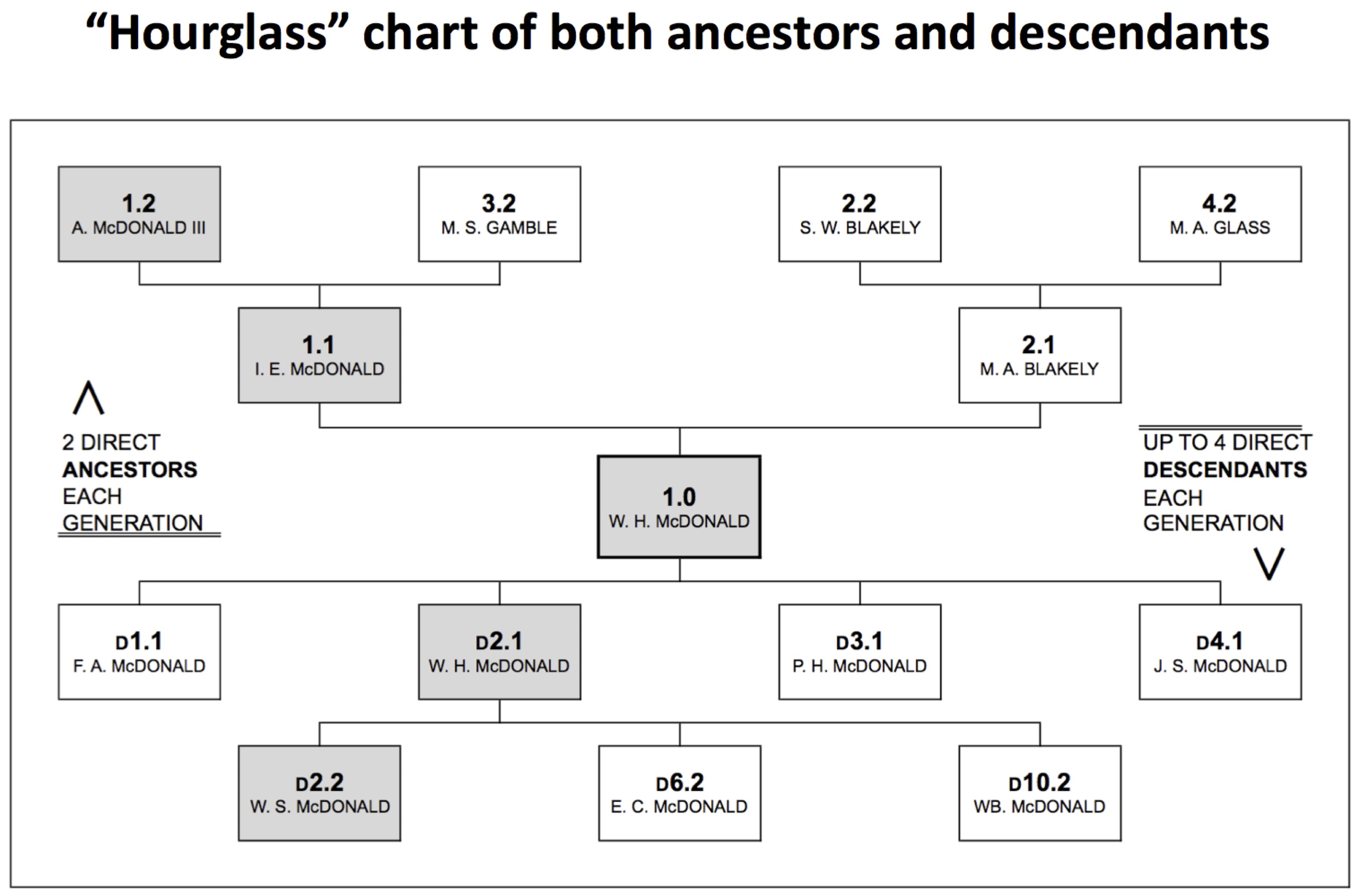
The value of a descendant lines numbering system that consistently accounts for all individuals (not merely those with currently-known offspring) is also evident. This is particularly valuable when others in such a system do not require re-numbering when additional descendants are added.
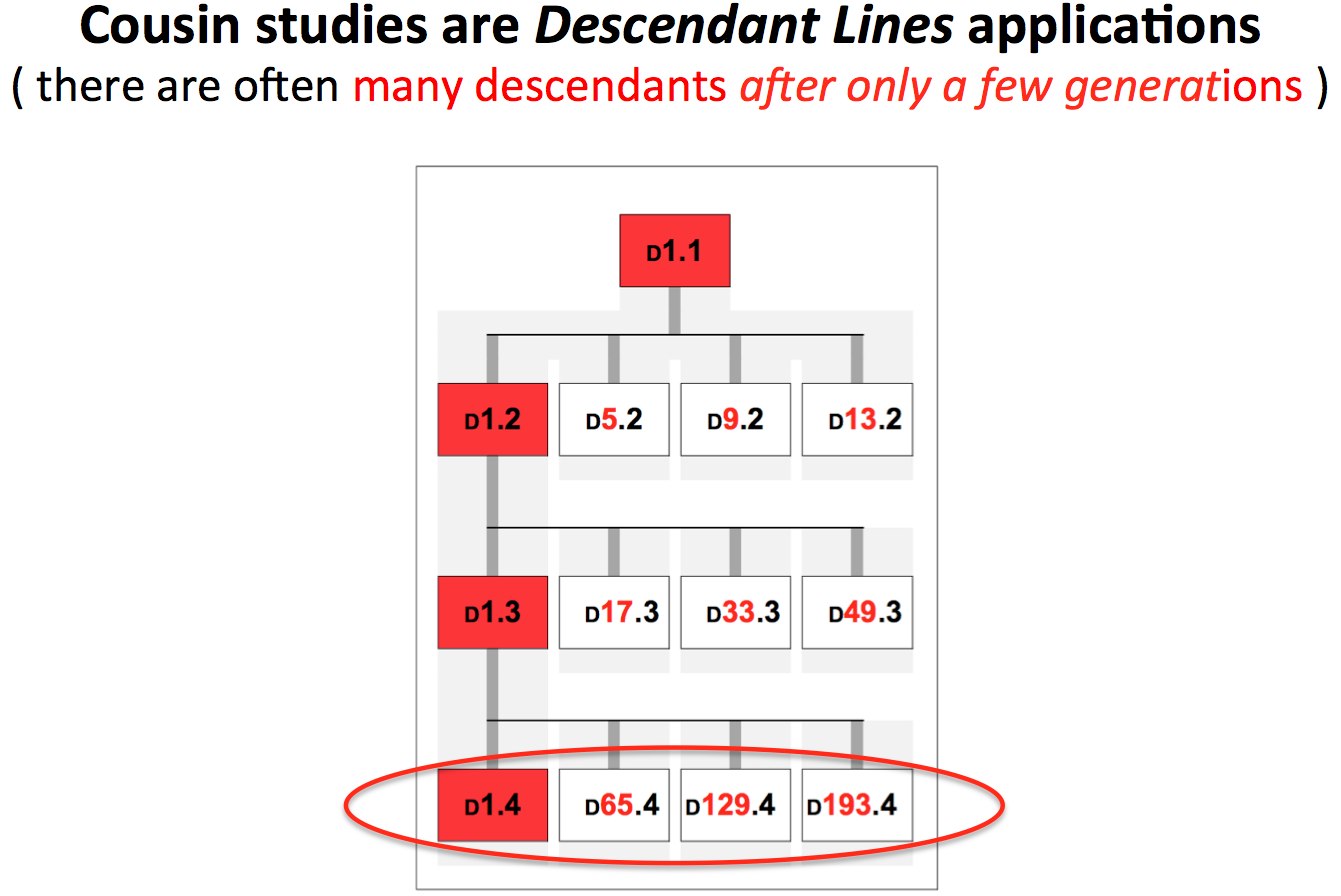
The utility of this approach is perhaps clearest with text and other non-tabular versions of the same information, as below. As is almost always found in reporting atDNA test matches, a significant number of “new” surnames (initially unknown in preceding genealogies) arises since daughters usually take their husband’s surname, and, over several generations, these cousins are “lost” to one another.

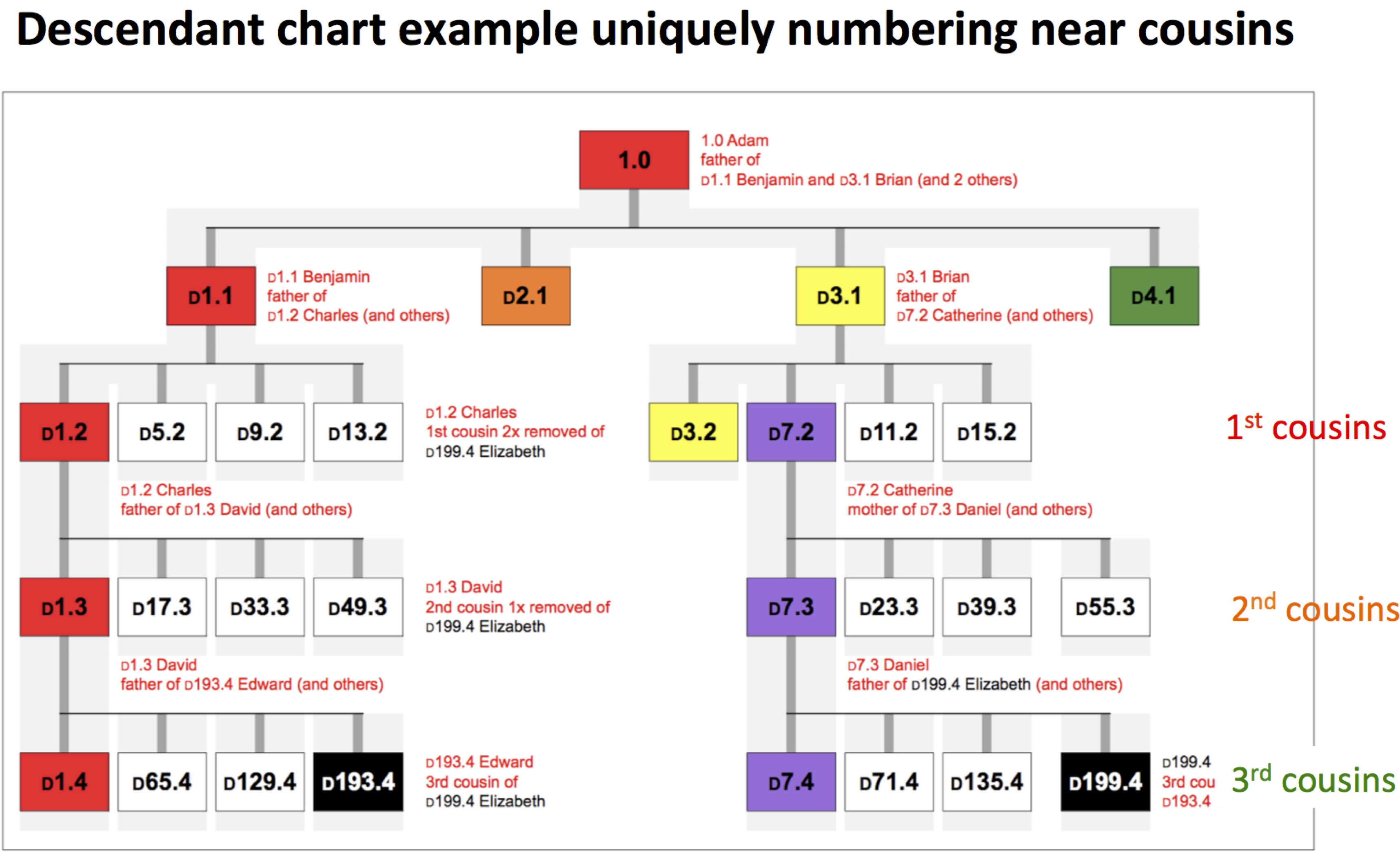
If descendant organization or a comprehensive ancestral and descendant system are among your interests, please email colleague@ancestrallines.net to contribute here and participate in this dialogue. Please include your own Website link or briefly state your reason(s) for interest.
Your participation is, once again, appreciated!
FamilyChartmasters Produces Ancestral Lines Numbered Charts
The good people at FamilyChartmasters have developed in-house expertise to produce several types of charts… These include their Generation Maps, as below, as well as traditional Ancestor Charts and Ancestor Charts with Siblings.
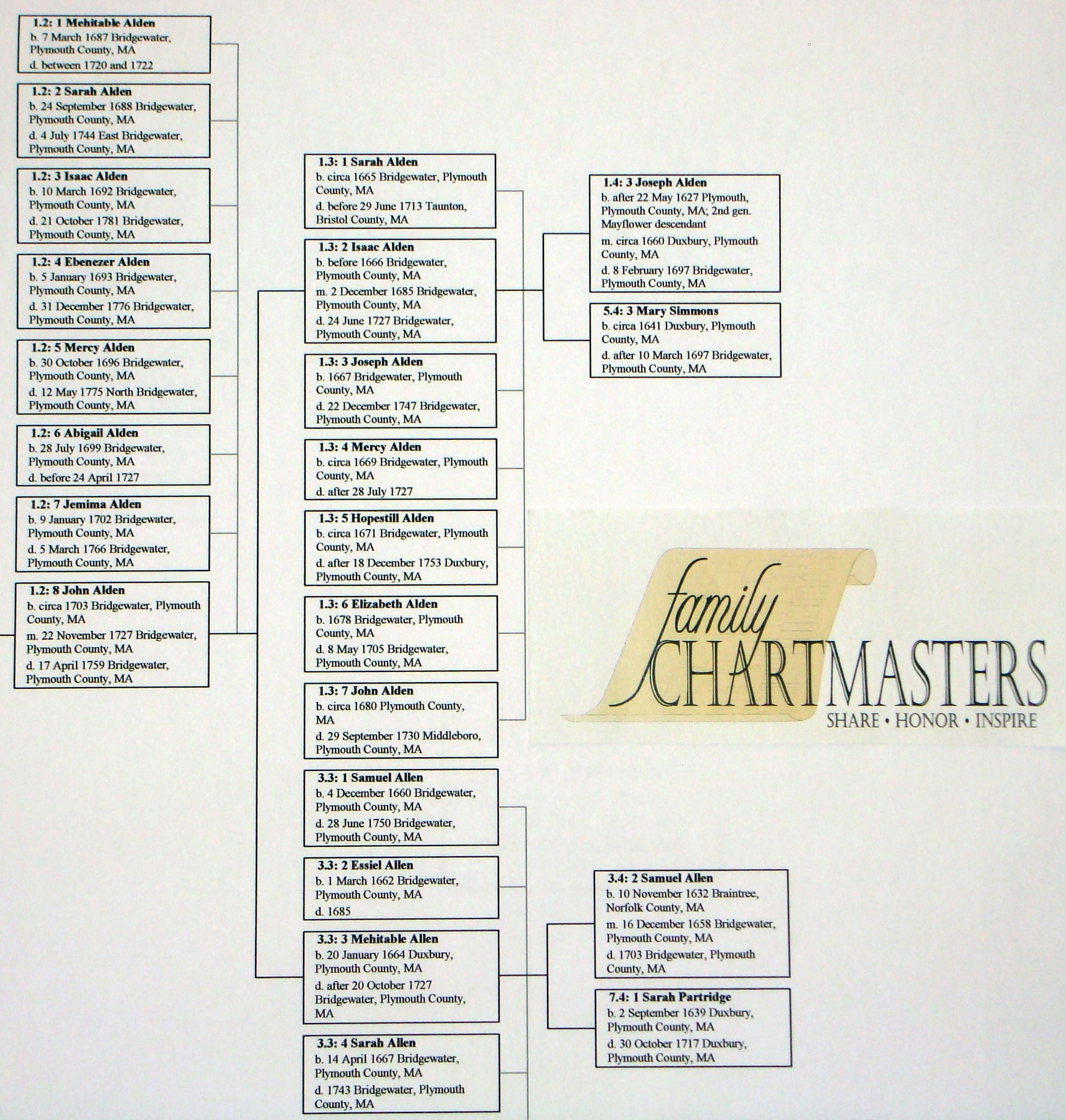
The Ancestral Lines Pairing System (Ancestral Lines) is freely available for personal record-keeping, research, education, and other non-commercial and commercial uses.
This website and all images it contains are being used for limited and noncommercial purposes, principally colleague and collaborator communications and shared learning.
